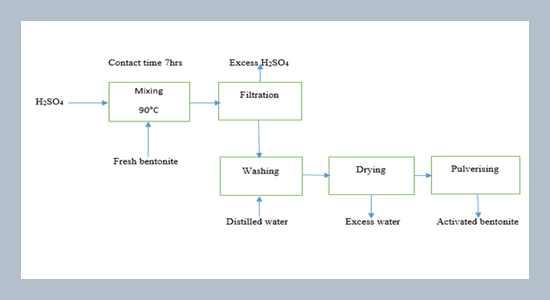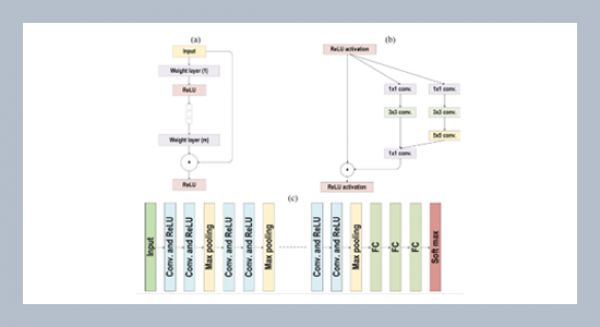REFERENCES
- Abdallah, W., Yilmazer, U. 2011. Novel thermally stable organo-montmorillonites from phosphonium and imidazolium surfactants. Thermochimica Acta, 525, 129–140.
- Abdullahi, S.L., Audu, A.A. 2017. Comparative analysis on chemical composition of bentonite clays obtained from Ashaka and tango deposits in Gombe State, Nigeria. ChemSearch Journal, 8, 35–40.
- Amalanathan, A.J., Harid, N. 2021. Impact of adding activated bentonite to thermally aged ester ‐ based TiO2 nanofluids on insulation performance. The institution of Engineering and Technology, 1–12.
- Betega, L., Paiva, D., Rita, A. Valenzuela, F.R. 2008. Applied clay science organoclays: Properties, preparation and applications. Applied Clay Science, 42, 8–24.
- Changchaivong, S., Khaodhiar, S. 2009. Adsorption of naphthalene and phenanthrene on dodecylpyridinium-modified bentonite. Applied Clay Science, 43, 317–321.
- Charis, G., Danha, G. 2020. Characterizations of biomasses for subsequent thermochemical conversion: A comparative study of pine sawdust and acacia tortilis. Processes 2020, 12, 546.
- Christidis, G.E., Scott, P.W., Dunham, A.C. 1997. Acid activation and bleaching capacity of bentonites from the islands of Milos and Chios, Aegean, Greece. Applied Clay Science, 12, 329–347.
- Deniz, C.U. 2020. A new mathematical approach to the bleaching process of edible oils. Journal of Chemical, Technology and Biotechnology, 95, 2430–2436.
- Didi, M.A., Makhoukhi, B., Azzouz, A., Villemin, D. 2009. Colza oil bleaching through optimized acid activation of bentonite. A comparative study. Applied Clay Science, 42, 336–344.
- Dinh, V., Nguyen, P., Tran,M., Luu, A., Hung,N.Q., Luu, T., Kiet, H.A.T., Mai, X., Luong T., Nguyen, T., Ho, H.T.T., Nguyen, D., Pham, D., Hoang, A., Lem, V., Nguyen, T. 2022. HTDMA-modified bentonite clay for effective removal of Pb(II) from aqueous solution. Chemosphere, 286, 131766.
- Edokpayi, J.N., Ndlovu, S.S., Odiyo, J.O. 2019. Synthesis and characterization of biopolymeric chitosan derived from land snail shells and its potential for Pb2+ removal from aqueous solution. Materials, 8, 8630–8640.
- Edokpayi, J.N, Ndlovu, S.S., Odiyo, J.O. 2019. Characterization of pulverized Marula seed husk and its potential for the sequestration of methylene blue from aqueous solution. BMC Chemistry, 1–14.
- Eliche-quesada, D., Corpas-iglesias, F.A. 2014. Utilisation of spent fi ltration earth or spent bleaching earth from the oil re fi nery industry in clay products. Ceramics International, 40, 16677–16687.
- Eren, E., Afsin, B., Onal, Y. 2009. Removal of lead ions by acid activated and manganese oxide-coated bentonite. Journal of Hazardous Materials, 161, 677–685.
- Erten, Y. 2004. Use of domestic minerals for vegetable oil bleaching. Izmir Institute of Technology, Turkey.
- Foletto, E.L., Colazzo, G.C., Volzone, C., Porto, L.M. 2011. Sunflower oil bleaching by adsorption onto acid-activated bentonite. Brazilian Journal of Chemical Engineering, 28, 169–174.
- Foo, K.Y., Hameed, B.H. 2010. An overview of dye removal via activated carbon adsorption process. Desalination and Water Treatment, 19, 255–274.
- Francis, K.A., Tahir, A.R. 2016. Evaluation of the physicochemical properties of Northern Ghana Sclerocarya birrea seed oil and proximate analysis of the process waste. African Journal of Food Science, 10, 48–53.
- Fuller, B., Gruner, J.W. 1940. Detected by the most prominent line of a cristobalite. Economic Geology, 35, 867–875.
- Galamboš, M., Mahmoodi, N.M., Ullah, H. 2021. Adsorption of malachite green dye onto mesoporous natural inorganic clays: Their equilibrium isotherm and kinetics studies. Water, 13, 965.
- Gates, W.P., Bouazza, A., Jock Churchman, G. 2009. Bentonite clay keeps pollutants at bay. Elements, 5, 105–110.
- Guliyev, N.G., Ibrahimov, H.J., Alekperov, J.A., Amirov, F.A., Ibrahimova, Z.M., Guliyev, N. 2018. Investigation of activated carbon obtained from the liquid products of pyrolysis in sunflower oil bleaching process. International Journal of Industrial Chemistry, 9, 277–284.
- Huang, Y., Chang, J.I. 2010. Biodiesel production from residual oils recovered from spent bleaching earth. Renewable Energy, 35, 269–274.
- Hui, T.S., Zaini, M.A.A. 2015. Potassium hydroxide activation of activated carbon: A commentary. Carbon Letters, 16, 275–280.
- Jegede, M.M., Durowoju, O.S., Edokpayi, J.N. 2021. Sequestration of hazardous dyes from aqueous solution using raw and modified agricultural waste. Adsorption Science and Technology.
- Kaufhold, S., Dohrmann, R., Ufer, K., Meyer, F.M. 2002. Comparison of methods for the quantification of montmorillonite in bentonites. Applied Clay Science, 22, 145–151.
- Kaynak, G., Ersoz, M., Kara, H. 2004. Investigation of the properties of oil at the bleaching unit of an oil refinery. Journal of Colloid and Interface Science, 280, 131–138.
- Liu, P. 2007. Polymer modified clay minerals : A review. Applied Clay Science, 38, 64–76.
- Liu, Y., Li, J., Wu, L., Shi, Y., He, Q., Chen, J., Wan, D. 2020. Science of the Total Environment Magnetic spent bleaching earth carbon (Mag-SBE @ C) for efficient adsorption of tetracycline hydrochloride : Response surface methodology for optimization and mechanism of action. Science of the Total Environment, 722, 137817.
- Lotfy, H.R., Misihairabgwi, J., Mutwa, M.M. 2012. The preparation of activated carbon from agroforestry waste for wastewater treatment. 6, 149–156.
- Maged, A., Kharbish, S., Ismael, I.S., Bhatnagar, A. 2020. Characterization of activated bentonite clay mineral and the mechanisms underlying its sorption for ciprofloxacin from aqueous solution. Environmental Science and Pollution Research, 27, 32980–32997.
- Makhoukhi, B., Didi, M.A., Villemin, D., Azzouz, A. 2009. Acid activation of bentonite for use as a vegetable oil bleaching agent. Grasas y Aceites, 60, 343–349.
- Mamvura, T.A., Pahla, G., Muzenda, E. 2018. Torrefaction of waste biomass for application in energy production in South Africa. South African Journal of Chemical Engineering, 25, 1–12.
- Mao, J., Guanglie, L., Zhou, R. 2020. Effect of acid-treated and hexadecyltrimethylammonium bromide - Modified montmorillonites on adsorption performance of mycotoxins. Environmental Science and Pollution Research, 27, 4284–4293.
- Martín, S.A., Rivera, A. 2021. Hosting of the antibiotic Vancomycin by bentonite : Characterization and slow release study. Applied Clay Science, 202, 105965.
- Mathew, M., Phineas, M.M., Isaac, G. 2017. Adsorption of a cationic dye by Marula (Sclerocarya birrea) fruit seed shell based biosorbent : Equilibrium and kinetic studies. African Journal of Biotechnology, 16, 1969–1976.
- Meziti, C., Boukerroui, A. 2011. Regeneration of a solid waste from an edible oil refinery. Ceramics International, 37, 1953–1957.
- Misihairabgwi, J.M., Kasiyamhuru, A., Anderson, P., Cunningham, C.J., Peshkur, T.A., Ncube, I. 2014. Adsorption of heavy metals by agroforestry waste derived activated carbons applied to aqueous solutions. African Journal of Biotechnology, 13, 1579–1587.
- Mkungunugwa, T., Manhokwe, S., Chawafambira, A., Shumba, M. 2021. Synthesis and Characterisation of Activated Carbon Obtained from Marula (Sclerocarya birrea) Nutshell. Journal of Chemistry, 2021.
- Molelekoa, T.B.J., Regnier, T., Da Silva, L.S., Augustyn, W.A. 2018. Potential of marula (Sclerocarya birrea subsp. caffra) waste for the production of vinegar through surface and submerged fermentation. South African Journal of Science, 114, 77–83.
- Monte, M.L., Monte, M.L., Pohndorf, R.S., Crexi, V.T., Pinto, L.A.A. 2015. Bleaching with blends of bleaching earth and activated carbon reduces color and oxidation products of carp oil. European Journal of Lipid Science and Technology, 117, 829–836.
- Moyo, M., Guyo, U., Mawenyiyo, G., Zinyama, N.P., Nyamunda, B.C. 2015. Marula seed husk (Sclerocarya birrea) biomass as a low cost biosorbent for removal of Pb (II) and Cu (II) from aqueous solution. Journal of Industrial and Engineering Chemistry, 27, 126–132.
- Naser, J., Avbenake, O.P., Dabai, F.N., Jibril, B.Y. 2021. Regeneration of spent bleaching earth and conversion of recovered oil to biodiesel. Waste Management, 126, 258–265.
- Nweke, O.M., Igwe, E.O., Nnabo, P.N. 2015. Comparative evaluation of clays from Abakaliki Formation with commercial bentonite clays for use as drilling mud, African Journal of Environmental Science and Technology, 9, 508–518.
- Ojewumi, M.E., Ehinmowo, A.B., Obanla, O.R., Durodola, B.M., Ezeocha, R.C. 2021. Comparative analysis on the bleaching of crude palm oil using activated groundnut hull, snail shell and rice husk. Heliyon, 7.
- Önal, M., Sarikaya, Y. 2007. Preparation and characterization of acid-activated bentonite powders. Powder Technology, 172, 14–18.
- Onwumelu, D.C. 2021. A comparative analysis of activated carbons from african teak (IROKO) wood and coconut shell in palm oil bleaching. Advanced International Journals of Research, 350.
- Patel, H.A., Somani, R.S., Bajaj, H.C., Jasra, R.V. 2007. Preparation and characterization of phosphonium montmorillonite with enhanced thermal stability. Applied Clay Science, 35, 194–200.
- Pathak, P.D., Mandavgane, S.A., Kulkarni, B.D. 2017. Fruit peel waste: Characterization and its potential uses. Current Science, 113, 444–454.
- Petit, S., Madejova, J. 2013. Fourier Transform Infrared Spectroscopy. Handbook of Clay Science. 5, 213-231.
- Postai, D.L., Demarchi, C.A., Zanatta, F., Melo, D.C.C., Rodrigues, C.A. 2016. Adsorption of rhodamine B and methylene blue dyes using waste of seeds of Aleurites Moluccana, a low cost adsorbent. Alexandria Engineering Journal, 55, 1713–1723.
- Rakereng, J., Muzenda, E., Gorimbo, J. 2019. Production of bio char and bio oils from botswana marula shells through torrefaction and pyrolysis. In 2019 7th International Renewable and Sustainable Energy Conference (IRSEC) IEEE, 1–5.
- Restiawaty, E., Maulana, A., Umi C., Neng T., Aslan, C., Suendo, V., Nishiyama, N., Budhi, Y.W. 2021. The removal of 3-monochloropropane-1,2-diol ester and glycidyl ester from refined-bleached and deodorized palm oil using activated carbon. RSC Advances, 11, 16500–16509.
- Salem, S., Salem, A., Babaei, A.A. 2015. Application of Iranian nano-porous Ca-bentonite for recovery of waste lubricant oil by distillation and adsorption techniques. Journal of Industrial and Engineering Chemistry, 23, 154–162.
- Salman, B., Ong, M.Y., Nomanbhay, S., Salema, A.A., Sankaran, R., Show, P.L. 2019. Thermal analysis of nigerian oil palm biomass with sachet-water plasticwastes for sustainable production of biofuel. Processes, 7, 475.
- Shin, K., Jaril, A., Boon, T., Mat, M., Ming, O. 2020. Revising degumming and bleaching processes of palm oil refining for the mitigation of 3-monochloropropane-1 , 2-diol esters (3-MCPDE) and glycidyl esters (GE) contents in refined palm oil, Food Chemistry, 307, 125545.
- Soetaredjo, F.E., Laysandra, L., Putro, J.N., Santoso, S.P., Angkawijaya, A.E., Yuliana, M., Ju, Y., Zhou, C., Ismadji, S. 2021. Ecological-safe and low-cost activated-bleaching earth: Preparation, characteristics, bleaching performance, and scale-up production, 279, 123793.
- Steudel, A., Batenburg, L.F., Fischer, H.R., Weidler, P.G., Emmerich, K. 2009. Alteration of swelling clay minerals by acid activation. Applied Clay Science, 44, 105–115.
- Tabak, A., Afsin, B., Caglar, B., Koksal, E. 2007. Characterization and pillaring of a Turkish bentonite (Resadiye), Journal of Colloid and Interface Science, 313, 5–11.
- Tai, Y.H., Lin, C.I. 2007. Variation of peroxide value in water-degummed and alkali-refined soy oil during bleaching under vacuum. Separation and Purification Technology, 56, 257–264.
- Toor, M., Jin, B., Dai, S., Vimonses, V. 2015. Activating natural bentonite as a cost-effective adsorbent for removal of Congo-red in wastewater. Journal of Industrial and Engineering Chemistry, 21, 653–661.
- Toor, M., Jin, B. 2012. Adsorption characteristics, isotherm, kinetics, and diffusion of modified natural bentonite for removing diazo dye. Chemical Engineering Journal, 187, 79–88.
- Topkafa, M., Ayyildiz, H.F., Arslan, F.N., Kucukkolbasi, S., Durmaz, F., Sen, S., Kara, H. 2013. Role of different bleaching earths for sunfl ower oil in a pilot plant bleaching system. Polish Journal of Food and Nutrition Sciences, 63, 147–154.
- Venaruzzo, J.L., Volzone, C., Rueda, M.L., Ortiga, J. 2002. Modified bentonitic clay minerals as adsorbents of CO, CO2 and SO2 gases. Microporous and Mesoporous Materials, 56, 73–80.
- Yang, H., Yan, R., Chen, H., Lee, D.H., Zheng, C. 2007. Characteristics of hemicellulose, cellulose and lignin pyrolysis. Fuel, 86, 1781–1788.
- Zhou, C.H. 2011. An overview on strategies towards clay-based designer catalysts for green and sustainable catalysis. Applied Clay Science, 53, 87–96.















